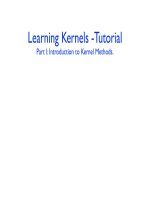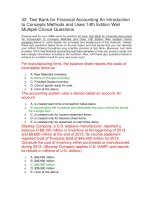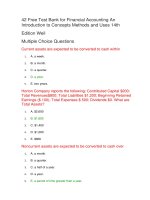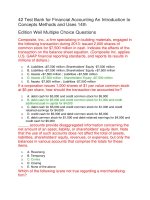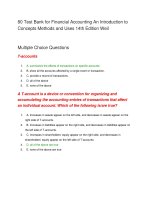Managerial accounting and introduction to concepts methods and user 11e by maher chapter 07
Bạn đang xem bản rút gọn của tài liệu. Xem và tải ngay bản đầy đủ của tài liệu tại đây (320.18 KB, 29 trang )
CHAPTER 7
PowerPoint Presentation by
LuAnn Bean
Professor of Accounting
Florida Institute of Technology
Differential Cost
Analysis for
Operating
Decisions
© 2012 Cengage Learning. All Rights Reserved. May
not be copied, scanned, or duplicated, in whole or in
part, except for use as permitted in a license
distributed with a certain product or service or
otherwise on a password-protected website for
classroom use.
Managerial Accounting 11E
Maher/Stickney/Weil
1
☼
CHAPTER GOAL
☼
This chapter explains how managers can use
differential analysis to examine the effects on
profits. Differential analysis helps managers
answer relevant questions such as:
What activities differ between the alternatives?
How does that difference affect costs and profits?
2
LO 1
DIFFERENTIAL
DIFFERENTIAL ANALYSIS:
ANALYSIS:
Definition
Definition
Is the analysis of differences
among particular alternative
actions.
3
U
E
M
LO 1
EXAMPLE: Ullman Educational Media
Ullman Educational Media (UEM) is a company that
produces tutorial videos for primary and preschool use.
UEM developed the following estimates:
Units made and sold
800 per month
Maximum production and sales capacity
Selling price
1,200 units per month
$ 30
Continued
4
U
E
M
LO 1
ACTIVITY & COSTS
Ullman Educational Media provides the following
information about activities and costs:
VC per unit FC per month
Manufacturing
Marketing and Administrative
Total costs
$ 17
$ 3,060
5
1,740
$ 22
$4,800
Continued
5
LO 1
U
E
M
Profit
Profit
decreases
decreases
by
by$1,000.
$1,000.
EXHIBIT 7.2
6
LO 1
CASH FLOW
Differential analysis focuses on cash flow
because
Cash is the medium of exchange in business
Cash is a common objective measure of the costs
and benefits of alternatives
7
LO 2
MANAGERS WANT TO KNOW!
Customer
Competitors’
Actions
Demands
Will
Willraising
raising
prices
priceslose
lose
customers
customers
totoaa
competitor
competitor
or
orcause
cause
them
themtoto
substitute
substitute
cheaper
cheaper
goods?
goods?
Pricing
Decisions
Cost of
Products
Managers
Managersmust
must
consider
consider
competitors
competitors
actions
actionsboth
both
nationally
nationallyand
and
internationally.
internationally.
Internal
Internalfocus
focus
on
oncontinuous
continuous
improvements
improvements
isiskey
keytoto
cutting
cuttingcosts.
costs.
8
U
E
M
MANAGERS WANT TO KNOW!
LO 2
SPECIAL ORDERS
Ullman
Ullman has
has an
an opportunity
opportunity for
for aa one-time
one-time
only
only special
special order
order to
to sell
sell 100
100 units
units at
at
$25
$25 each.
each. The
The regular
regular price
price is
is $28.
$28.
Should
Should they
they accept
accept the
the special
special order?
order?
Continued
9
UE
M
LO 2
EXHIBIT 7.3
Yes!
Yes!Since
Since
normal
normal
operations
operations
should
shouldbe
beused
usedtoto
cover
coverFC,
FC,not
not
special
specialorders,
orders,
this
thisspecial
specialorder
order
adds
adds$300
$300to
tothe
the
bottom
bottomline.
line.
10
Full
Fullcost,
cost,used
usedfor
forlong
long
run
rundecisions,
decisions,isisthe
thetotal
total
cost
costof
ofproducing
producingand
and
selling
sellingaaunit.
unit.
EXHIBIT 7.5
LO 2
U
E
M
11
LO 2
PRICING DECISIONS
Use of full cost in pricing decisions is justified
because
In the long run, prices must cover all costs to
survive
Long term contractual agreements must cover all
costs
Prices in regulated industries are often based on
full cost
Although full cost + profit may be used initially,
short term adjustments may reflect market
conditions.
12
LO 2
PRODUCT
PRODUCT LIFE
LIFE CYCLE:
CYCLE:
Definition
Definition
Covers the time from initial
research and development to
time support to customer is
withdrawn.
13
LO 2
Predatory
Predatory pricing:
pricing: Definition
Definition
Is when a business deliberately prices
below its costs to drive out competitors.
Dumping:
Dumping: Definition
Definition
Occurs when a foreign company sells a
product in the U.S. at a price below the
market value in the country of its creation.
14
LO 3
What is target
cost?
Target cost is the target
price less the target profit.
15
Value
Valueengineering
engineeringisisaa
systematic
systematicevaluation
evaluationof
of
all
allaspects
aspectsof
ofthe
the
business.
business.
EXHIBIT 7.5
LO 3
16
LO 4
USING ACTIVITY-BASED
COSTING: Analyze Profitability
Customer cost
Activities
Cost to acquire customer
Promote product; campaign to
win lost customers; run
advertising campaign
Cost to provide goods and services
Process order; deliver product;
process returns
Cost to maintain customers
Bill customers; process
payments; issue refunds
Cost to retain customers
Follow-up calls
17
LO 6
THEORY OF CONSTRAINTS
The
The theory
theory of
of constraints
constraints (TOC)
(TOC) acknowledges
acknowledges
that
that businesses
businesses often
often have
have constraints
constraints or
or
limits
limits on
on what
what can
can be
be done.
done. TOC
TOC encourages
encourages
managers
managers to
to identify
identify where
where constraints
constraints arise
arise
and
and to
to develop
develop methods
methods to
to manage
manage them.
them.
Three
Three factors
factors predominate:
predominate:
1.
1. Throughput
Throughput contribution
contribution
2.
2. Investments
Investments
3.
3. Other
Other operating
operating costs
costs
18
LO 6
BOTTLENECK:
BOTTLENECK: Definition
Definition
Is an operation in which the
work to be performed equals or
exceeds the available capacity.
19
MANAGING THE
BOTTLENECK
LO 6
Recognize that the bottleneck resource determines
throughput contribution of product
Search for, find bottleneck
Resource with large quantities of inventory waiting to be
worked on
Subordinate all non-bottleneck resources to the
bottleneck resource
Increase bottleneck efficiency, capacity
Repeat 4 steps for any new bottleneck
20
LO 7
MAKE-OR-BUY
The
The make-or-buy
make-or-buy decision
decision is
is one
one where
where the
the
firm
firm must
must decide
decide whether
whether to
to meet
meet its
its
needs
needs internally
internally or
or to
to acquire
acquire goods
goods or
or
services
services externally.
externally. Both
Both cost
cost and
and nonnonquantitative
quantitative factors
factors are
are considered.
considered.
21
MANAGERS WANT TO KNOW!
LO 8
JOINT PRODUCTS
In
In some
some circumstances,
circumstances, multiple
multiple products
products
can
can be
be produced
produced from
from aa single
single
production
production process.
process. The
The question
question for
for
management
management is:
is: What
What is
is the
the effect
effect of
of
additional
additional processing/production
processing/production on
on
profits?
profits?
22
LO 8
SPLITOFF
SPLITOFF POINT:
POINT: Definition
Definition
Is the point up to which all
costs are joint and after which
additional processing costs are
identified with other products.
23
LO 9
MANAGERS WANT TO KNOW!
ADD OR DROP
Managers
Managers must
must decide
decide when
when to
to add
add or
or drop
drop
products;
products; when
when to
to open
open or
or abandon
abandon
sales
sales territories.
territories. The
The differential
differential
principle
principle involved
involved can
can be
be stated:
stated:
If
If differential
differential revenue
revenue from
from selling
selling exceeds
exceeds
differential
differential costs
costs of
of product,
product, the
the product
product is
is
profitable
profitable and
and the
the firm
firm should
should continue
continue
production.
production.
Click the button to
skip Example
24
MANAGERS WANT TO KNOW!
LO 10
INVENTORY MANAGEMENT
Inventory
Inventory has
has aa direct
direct affect
affect on
on profit
profit and
and
must
must be
be carefully
carefully managed.
managed. Key
Key
questions
questions for
for managers
managers are:
are:
1.
1. How
How many
many units
units should
should be
be on
on hand
hand for
for use
use
or
or sale?
sale?
2.
2. How
How often
often should
should the
the firm
firm order
order an
an item
item
and
and what
what is
is the
the optimal
optimal order
order size?
size?
25
